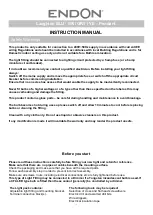
33
KX-TG7100HGS/KX-TG7102HGS/KX-TGA711FXS
(
G
)* Hookswitch Check with
DC Characteristics
-
1. Connect CN1 (Telephone Socket) to Tel-simulator which is connected with
600
Ω
.
2. Set line voltage to 48 V and line current to 40mA at off-hook condition of nor-
mal telephone.
3. Execute the command “hookoff”
4. Confirm that the line current is 40 mA ± 5 mA.
5. Execute the command “hookon”.
6. Confirm that the line current is less than + 0.8 mA.
L1, L2, Q3, R14,
R15, Q4, R16,
R17, IC7, D3
(
H
)* DTMF Generator Check
-
1. Connect CN1 (Telephone Socket) to DTMF tester. (Road=600
Ω
)
2. Link Handset and push dial key.
3. Confirm DTMF character.
4. Confirm that the high Group is -5.0 dBm ~ -9.0 dBm.
5. Confirm that the low Group is -8.0 dBm ~ -12.0 dBm.
IC7, R67, IC6,
R116, C141,
R29, C22, C23,
R18~R24,
C14~C17, Q5,
D4
(
I
)* Transmitted Power Con-
firmation
-
Remove the Antenna before starting step from 1 to 7.
1. Configure the DECT tester (CMD60) as follows;
<Setting>
• Short A_1 and GND.
• Test mode: FP
• Traffic Carrier: 5
• Traffic Slot: 4
• Mode: Loopback
• PMID: 00000
• RF LEVEL = -70dBm.
2. Execute the command “testmode”.
3. Execute the command “sendchar dmv 2 2”.
4. Check that “Signalling Status” has been set to “Locked”, then press “ACCEPT
RFPI”.
5. Initiate connection from Dect tester (“set up connect”)
6. Execute the command “ANT1”.
7. Confirm that the NTP value at ANT is 20 dBm ~ 25 dBm.
IC7, IC10, L7,
L3, L4, L6,
C117, C118,
C119, C120,
C124, C125,
R106, R109,
DA1, C102,
R102, R103,
Q10, C110,
C112, R111,
C126, C127,
R112
(
J
)
Modulation Check and
Adjustment
-
Follow steps 1 to 6 of
(I)
.
7.Confirm that the B-Field Modulation is -350 ~ -400/+320 ~ +370 kHz/div using
data type Fig31.
8.Adjust the B-Field Modulation if required. (Execute the command “readmod”
and “wrtmod xx”, where xx is the value.)
IC7, IC10, L7,
L3, L4, L6,
C117, C118,
C119, C120,
C124, C125,
R106, R109,
DA1, C102,
R102, R103,
Q10, C110,
C112, R111,
C126, C127,
R112
(
K
) Frequency Offset Check
-
Follow steps 1 to 6 of
(I)
.
7.Confirm that the frequency offset is < ± 45 kHz.
IC7, IC10, L7,
L3, L4, L6,
C117, C118,
C119, C120,
C124, C125,
R106, R109,
DA1, C102,
R102, R103,
Q10, C110,
C112, R111,
C126, C127,
R112
(
L
)
Frequency Dirft Confir-
mation
-
Follow steps 1 to 6 of
(I)
.
7.Confirm that the frequency drift is < ± 30 kHz/ms.
IC7, IC10, L7,
L3, L4, L6,
C117, C118,
C119, C120,
C124, C125,
R106, R109,
DA1, C102,
R102, R103,
Q10, C110,
C112, R111,
C126, C127,
R112
Items
Check
Point
Procedure
Check or
Replace Parts
Summary of Contents for KX-TG7100HGS
Page 2: ...2 KX TG7100HGS KX TG7102HGS KX TGA711FXS ...
Page 13: ...13 KX TG7100HGS KX TG7102HGS KX TGA711FXS 4 6 Signal Route ...
Page 19: ...19 KX TG7100HGS KX TG7102HGS KX TGA711FXS 7 4 For Service Hint ...
Page 20: ...20 KX TG7100HGS KX TG7102HGS KX TGA711FXS 8 Service Mode 8 1 Engineering Mode 8 1 1 Base Unit ...
Page 22: ...22 KX TG7100HGS KX TG7102HGS KX TGA711FXS 8 1 2 Handset ...
Page 28: ...28 KX TG7100HGS KX TG7102HGS KX TGA711FXS Cross Reference Check Point Base Unit P 32 ...
Page 42: ...42 KX TG7100HGS KX TG7102HGS KX TGA711FXS 10 1 2 Handset ...
Page 43: ...43 KX TG7100HGS KX TG7102HGS KX TGA711FXS 10 1 3 Charger Unit ...
Page 44: ...44 KX TG7100HGS KX TG7102HGS KX TGA711FXS 10 2 How to Replace the Handset LCD ...
Page 73: ...73 KX TG7100HGS KX TG7102HGS KX TGA711FXS 15 3 Cabinet and Electrical Parts Charger Unit ...
Page 75: ...75 KX TG7100HGS KX TG7102HGS KX TGA711FXS 15 4 2 KX TG7102HGS ...
















































